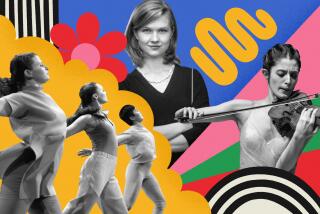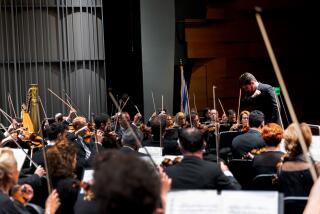A Moving Triumph for Klezmer Conservatory
- Share via
IRVINE — In concert halls around the world, the Klezmer Conservatory Band has not only brought audiences to their feet but has consistently left them dancing in the aisles, boasts the back cover of the Boston-based Yiddish music ensemble’s latest album, “Dancing in the Aisles.”
Such chutzpah. Didn’t they know they might someday have to play at the Irvine Barclay Theatre? It’s the Sargasso Sea of concert halls, where muted decor and a library-like hushed atmosphere make for a fine listening room, but tend to becalm any would-be dancers.
Celebrated Cajun musicians, accustomed to inspiring crushes of waltzers and two-steppers, have played on bemusedly at this venue, their entreaties that Cajun is dance music having fallen on appreciative ears attached to immobile feet.
A lot more people in Orange County have been to a traditional Jewish wedding or bar mitzvah, where klezmer is often featured, than to a Cajun dance. So when singer Judy Bressler called, just before intermission Saturday night, for dancers in the aisles, she got at least 10% compliance from the 750 or so sets of feet in the sold-out theater. For the show’s finale, she started the line dance herself, and got about 30 takers to follow her through the aisles. Not a triumph, exactly, but enough of a showing for the Klezmer Conservatory Band to live up to its copy.
The 11-member group was outstanding in demonstrating just how adaptable and diverse klezmer is. The Yiddish-language music originated in Europe and carries lots of echoes from Jewry’s Middle Eastern origins. It enjoyed perhaps half a century of vitality in America before assimilation and modernization turned Yiddish into a dormant tongue and klezmer into an abandoned art. Since 1980, the KCB has been a leading force in the music’s revival.
Musical director Hankus Netsky assembled the band’s repertoire from old recordings and sheet music or from talks with aged musicians. Onstage, it made for a lively, flowing evening in which the settings and moods included a classically tinged piano and flute duet, a swing-flavored quartet, a tango and a Gypsy-like folk duo of guitar and violin. The peak moments came from a colorful, tightly coordinated full ensemble racing through lively dances known as bulgars and freylekhs.
*
Carrying the show were two impressive stars, singer Bressler and clarinetist Ilene Stahl.
Stahl was as fine an embodiment of musical vitality and stage presence as one could hope to find in or out of klezmer, which has a tradition of great clarinetists. A tall woman in a crown of tight brown curls and a striking red dress, she captivated the crowd from her first solo of the evening, with lines that swooped and glided through musical space, or that expertly captured human voicings at peaks of glee or sorrow. She often leavened the sorrow with sprightly rhythms or shadowed the glee by pushing the high peals of laughter beyond pleasure into a zone of frantic desperation to enjoy good times while they last. Throughout, she intensified the music with vibrant body Yiddish--ankle-twisting dance steps and an assortment of radical torso bends.
Bressler was an expert ham, excuse the expression, who worked the theatrical traditions of Yiddish music. Her voice wasn’t massive, but it was clear and conversationally flexible. She provided needed translation in the least academic and most entertaining way: little monologues delivered with the knowingly quizzical accent and tone of Jewish New York. She brought a palpable ache to the torch ballad “Farges Mikh Nit” (“Don’t Forget Me”) and was pure helium on the Yiddish standard “Rumenye, Rumenye” (“Romania, Romania”), a giddy tall tale about high living in the old country.
It’s among the cultural surprises of recent years that Yiddish music is living high again in the new country, with a proliferation of bands and recordings. Could the mass audience that has rediscovered swing and trad-jazz through the clunky but platinum-selling revivalist band Squirrel Nut Zippers latch onto klezmer next? In a retro era that looks backward for its next pop morsel, it’s a faddish possibility. Worse things could happen than a band as vibrant and skilled as the KCB freylekhing and frolicking into the mainstream.
More to Read
The biggest entertainment stories
Get our big stories about Hollywood, film, television, music, arts, culture and more right in your inbox as soon as they publish.
You may occasionally receive promotional content from the Los Angeles Times.











